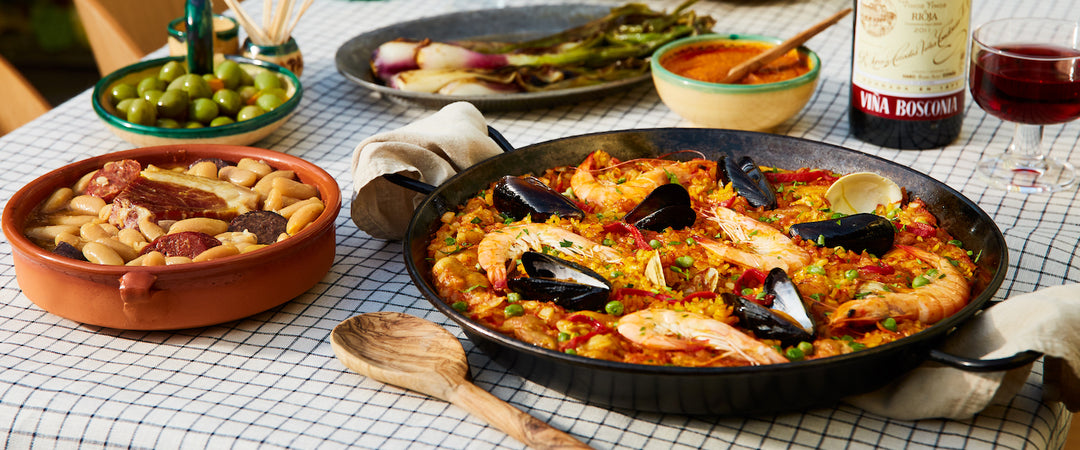July 2025 Blanco y Tinto Club
 |
Señorio De P. Pecina 2016 Regular Price: $35.99
Club Price: $30.59
|
Front matter: all images courtesy Hermanos Pecina (website, instagram).
We’ve been to Rioja multiple times, and in each visit, one truth keeps surfacing: the wines we love the most (the ones we come home talking about the most) almost always come from La Rioja Alta, and more specifically, from the vineyard surrounding the village of San Vicente de la Sonsierra. It’s not the modern architecture, flashy, big estate part of Rioja, but it’s where the magic grounded in history happens. Grapes from old vines growing in a patchwork of limestone hills, Atlantic breezes, and a deep-rooted culture of winemaking that doesn’t chase trends all coalesce into that “je ne sais quoi” that makes us go oohh and ahh not just at scenery like that below, but at all the wines that come from it.

Bodegas Hermanos Peciña captures everything we admire about this place. Founded in 1992 by Pedro Peciña after decades working at La Rioja Alta (yes, that La Rioja Alta), the winery sticks to a traditional path: estate-grown grapes (more on that below), organic farming, native yeasts, and long, slow aging in used American oak. They rack every barrel by hand, every six months, the old-fashioned way, not because it’s nostalgic, but because it makes better wine.

And, since winemaking technique means nothing if it's not applied to good fruit, a closer look at their vineyards is very important.
Peciña’s vineyards are a study in balance — between altitude and aspect, tradition and precision. Spread across 50 hectares around San Vicente de la Sonsierra, each parcel brings something distinct to the table. Finca Iscorta, the oldest and most emblematic, is a 50-year-old bush-trained vineyard where Tempranillo, Garnacha, and Viura ripen slowly on a north-facing slope at 500 meters. From there, the vineyards climb even higher: Salinillas sits over 600 meters in the foothills of the Toloño Mountains — the western edge of Rioja DOCa — delivering the acidity and freshness that define Peciña’s style. El Codo, a dramatic, stony hillside vineyard ranging from 485 to 575 meters, yields deeply concentrated fruit from its stressed, well-drained soils. La Liende, La Peña, and Llano each add their own layers, from the water-retentive floodplain soils that keep vines digging deep, to the high-altitude limestone plots that offer structure, spice, and purity. Even their youngest planting, La Veguilla, along the banks of the Ebro, contributes bright, floral energy to the blend. Finally, La Tejera’s Garnacha and Valseca’s Tempranillo — grown near the winery in clay-limestone soils with good wind exposure — round out the picture with finesse, tannic grip, and lift. These are vineyards with personality, shaped by place, farmed with care, and blended to capture the soul of Sonsierra.


We keep returning to these bottles year after year because they’re honest. They’re elegant without being precious. They show the power of restraint and the beauty of time. Whether it’s their Crianza, Reserva, or Gran Reserva, Peciña delivers Rioja that’s timeless, grounded, and completely compelling. While we often make fun of their overly staid, plain, and excessively old fashioned serif font labels (which honestly really contributes to the wine getting passed by), it is one of the best picks on our shelves and precisely because of said label it’s one of our best-kept secrets.
The Reserva is where Peciña really flexes. Aged three years in used American oak and another two in bottle before release, the 2016 is textbook in all the right ways. The blend is dominated by Tempranillo (95%) with classic additions of Graciano (3%) and Garnacha (2%). It's not flashy, not modern, but deep, polished, and incredibly graceful. This is Rioja in its long-form: slower to open, built to last, and quietly unfolding over time.
The aromatics lean savory: cured tobacco, dried cherry, dusty herbs, sandalwood, with subtle fruit and spice threading through. On the palate, the structure is firmer than the Crianza but still silken, with a mineral core and long, persistent finish. It’s the kind of wine that rewards a decant and a good conversation.
2016 was a cooler vintage in Rioja, and it shows in the wine’s lift and linear focus. It’s drinking beautifully now, but has the bones to cellar for another decade or more. If the Crianza is a weeknight triumph, this is your Tomahawk Steak bottle.
 
|
Bodegas Carballal 2024
|
This month, we’re thrilled to feature two wines from Bodegas Carballal, a family-run estate in the Salnés Valley the historic heart of Rías Baixas and birthplace of the Albariño grape. Recognized as a Denomination of Origin (DO) in 1988, Rías Baixas now includes over 150 wineries across five subzones, all influenced by the region’s Atlantic climate and low-lying, coastal geography. Bodegas Carballal’s connection to the region runs deep.

The family’s patriarch, Benito Vázquez, was one of the original growers who helped establish the DO. Today, the winery continues to champion pure, expressive Albariño from their organically farmed vineyards in Salnés.

Tasting these two wines side by side Sete Cepas and the En Rama bottling offers a glimpse into just how much character Albariño can show when made with care and intention.
From the windswept Salnés Valley in Rías Baixas, widely considered the birthplace of Albariño, comes this vivid, salt-tinged expression from Bodegas Carballal. The Carballal family has farmed these granite-rich vineyards for generations, using organic practices and working gently in the cellar. The name ”Sete Cepas” (Seven Vines) honors the seven brothers who now carry on the family’s winemaking tradition.
The 2024 vintage is fermented with native yeasts and aged on fine lees for just the right amount of time, giving it energy and texture without weight. What I love about this wine is its immediacy, it opens with aromas of citrus blossom and white peach, and follows through with mouthwatering acidity and a whisper of sea spray on the finish. It’s the kind of Albariño you want to drink cold on a sunny afternoon, especially with oysters or grilled shrimp. Pure and bright, this is classic coastal Galicia in a glass.
 
|
Bodegas Carballal 2024
|
If Sete Cepas is the breezy, youthful side of Albariño, Carballal’s Albariño En Rama is its more introspective sibling. “En Rama” roughly translates to “raw” or “in its natural state” a term borrowed from the sherry world that signals a wine bottled with minimal filtration and intervention. Here, the result is a deeper, more of a textured version of Albariño that still holds on to the grape’s essential freshness.
Made from older vines and aged longer on its lees, the wine shows a beautiful evolution in the glass. Aromatically, it’s definitelymore complex: think white flowers, preserved lemon, and a touch of almond skin. On the palate, it’s creamier and broader than the Sete Cepas, but not heavy at all. There’s a quiet intensity to it, something savory and mineral under the fruit, like wet stones or a sea breeze rolling through fog.
Tasting it next to the Sete Cepas is a reminder of how much range Albariño has when handled thoughtfully. It’s not just a summer sipping wine, it’s a serious, age-worthy white with lots of layers.
Albariño is often considered a “summer wine,” and while it certainly shines in warm weather, these two bottles from Bodegas Carballal show there’s far more to explore. The 2024 Sete Cepas offers the clean, coastal lift we love, while the En Rama invites a slower sip, something to return as it opens up.
Together, they tell a story of place, and a grape that’s far more versatile than it often gets credit for. We hope you enjoy diving in.



